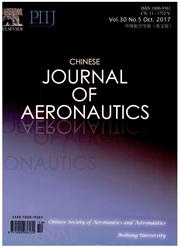

 中文摘要:
中文摘要:
Remaining useful life(RUL) prognostics is a fundamental premise to perform conditionbased maintenance(CBM) for a system subject to performance degradation. Over the past decades,research has been conducted in RUL prognostics for aeroengine. However, most of the prognostics technologies and methods simply base on single parameter, making it hard to demonstrate the specific characteristics of its degradation. To solve such problems, this paper proposes a novel approach to predict RUL by means of superstatistics and information fusion. The performance degradation evolution of the engine is modeled by fusing multiple monitoring parameters, which manifest non-stationary characteristics while degrading. With the obtained degradation curve,prognostics model can be established by state-space method, and then RUL can be estimated when the time-varying parameters of the model are predicted and updated through Kalman filtering algorithm. By this method, the non-stationary degradation of each parameter is represented, and multiple monitoring parameters are incorporated, both contributing to the final prognostics. A case study shows that this approach enables satisfactory prediction evolution and achieves a markedly better prognosis of RUL.
 英文摘要:
英文摘要:
Remaining useful life(RUL) prognostics is a fundamental premise to perform conditionbased maintenance(CBM) for a system subject to performance degradation. Over the past decades,research has been conducted in RUL prognostics for aeroengine. However, most of the prognostics technologies and methods simply base on single parameter, making it hard to demonstrate the specific characteristics of its degradation. To solve such problems, this paper proposes a novel approach to predict RUL by means of superstatistics and information fusion. The performance degradation evolution of the engine is modeled by fusing multiple monitoring parameters, which manifest non-stationary characteristics while degrading. With the obtained degradation curve,prognostics model can be established by state-space method, and then RUL can be estimated when the time-varying parameters of the model are predicted and updated through Kalman filtering algorithm. By this method, the non-stationary degradation of each parameter is represented, and multiple monitoring parameters are incorporated, both contributing to the final prognostics. A case study shows that this approach enables satisfactory prediction evolution and achieves a markedly better prognosis of RUL.
 同期刊论文项目
同期刊论文项目
 同项目期刊论文
同项目期刊论文
 Application of a state space modeling technique to system prognostics based on a health index for co
Application of a state space modeling technique to system prognostics based on a health index for co Prognostics Uncertainty Reduction by Fusing On-line Monitoring Data Based on a State-Space-Based Deg
Prognostics Uncertainty Reduction by Fusing On-line Monitoring Data Based on a State-Space-Based Deg Experimental study on engine gas-path components fault monitoring using exhaust gas electrostatic si
Experimental study on engine gas-path components fault monitoring using exhaust gas electrostatic si 期刊信息
期刊信息
